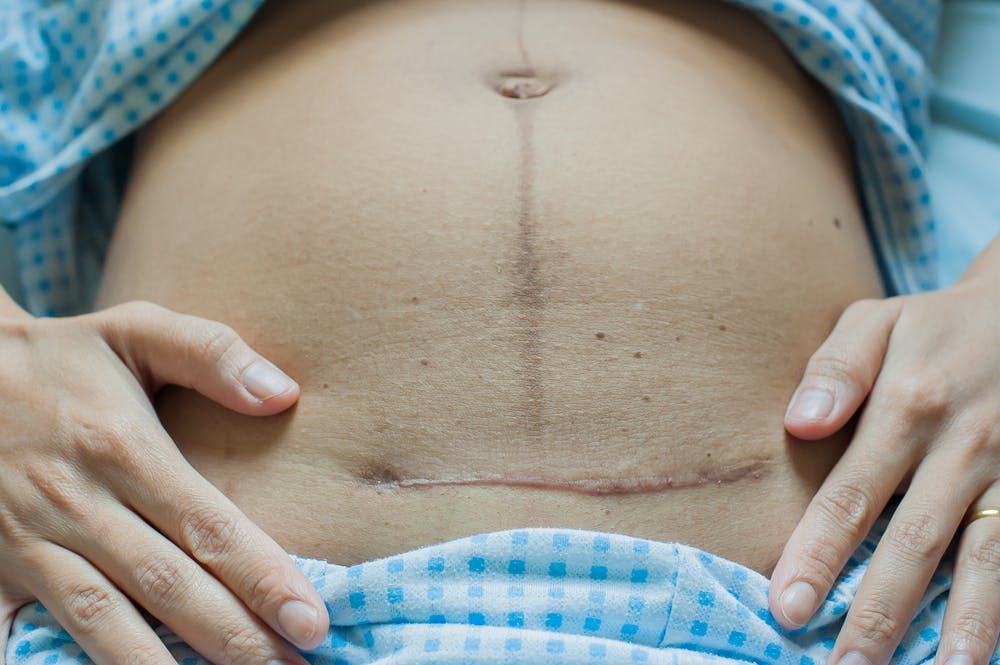Cesarean scars often mean different things to patients and doctors. For most patients, their biggest concern is the appearance of the scar. For physicians, their biggest concern is scarring to the abdomen and uterus that may impact a patient's health and future pregnancies.
StatPearls notes three broad categories of indications for a cesarean section: maternal, anatomic and fetal. Individual reasons can range from a prolapsed umbilical cord to an obstructive mass in the genital tract. C-sections are also on the rise globally, reports the World Health Organization (WHO).
A cesarean section delivery involves two primary incisions: one in the abdomen (laparotomy) and one in the uterus (hysterotomy). These incisions are generally made either laterally (also referred to as "transverse") or vertically (referred to as "classical"). A vertical incision, which is used more often during emergency procedures, typically results in the need for cesarean delivery in all subsequent pregnancies.
Recognizing Complications From Cesarean Sections
The European Journal of Radiology Open (EJRO) reports that rates of cesarean sections are currently higher than they should be for what experts consider strictly optimal or necessary. The WHO suggests an optimal rate of 10-15 percent for maternal and fetal health, but in the United States, the rate varies by state from 22.9 percent to 38.2 percent, according to the Centers for Disease Control. In Latin America and the Caribbean, the WHO records rates as high as 43 percent.
As the EJRO researchers point out, this increase in cesarean delivery rates leads to an increase in future pregnancy complications, ranging from uterine rupture to cesarean scar pregnancy, a rare form of ectopic pregnancy. Further, scarring from c-sections can cause complications such as dehiscence and abdominal and pelvic adhesions.
The type of incision can impact future pregnancies, but it appears that the level of the incision (high or low) may affect scarring more depending on the stage of labor. A study of 114 patients published in Ultrasound in Obstetrics and Gynecology found that large uterine scar defects were more frequently found in patients who had a low incision during advanced labor than in those who had a high incision. Using transvaginal ultrasound examination between six and nine months after delivery, researchers found that 41 percent of the women with low incisions during late-stage labor had large scar defects. However, of the 56 women who had subsequent pregnancies within the next five years, there was no difference in the rate of complications between low- and high-level incision groups.
Educating Patients on C-Section Risks
Patients who request planned cesarean sections should be counseled not only about the long-term risks to future pregnancies but also about the short-term risks, including infection at the incision site and within the abdomen, hemorrhage, organ injuries and extended hospital stay and recovery time.
Patients often have aesthetic concerns about cesarean scars. Scars that become hypertrophic or develop keloids can be uncomfortable, but patients also may think of them as unsightly. Directing patients to online pregnancy resources that have tips about wound care can help to reinforce the physician's instructions.
Some patients may wish to improve the scar's appearance. Noninvasive treatments range from silicon sheeting or creams to steroid injections and laser treatments. More invasive therapy could include revision surgery.
Evaluating Cesarean Scars With Ultrasound
Research published in the Journal of Ultrasonography emphasizes the importance of ultrasound evaluation in patients with a previous cesarean section looking to become pregnant again, citing a cesarean scar defect prevalence rate of up to 70 percent. However, even in the absence of pregnancy, these defects can cause sequelae such as decreased fertility, abnormal bleeding and pelvic pain. The researchers suggest ultrasound evaluation shortly after menstruation, when the endometrium is at its thinnest.
Although patients usually expect cesarean scars, they may not be aware of the myriad complications that can occur following this procedure. Careful post-cesarean management and future pregnancy planning can help to mitigate risk and prepare for potential future complications.



